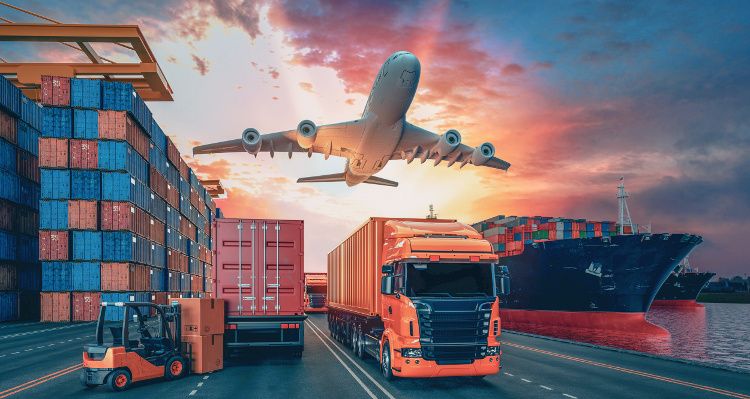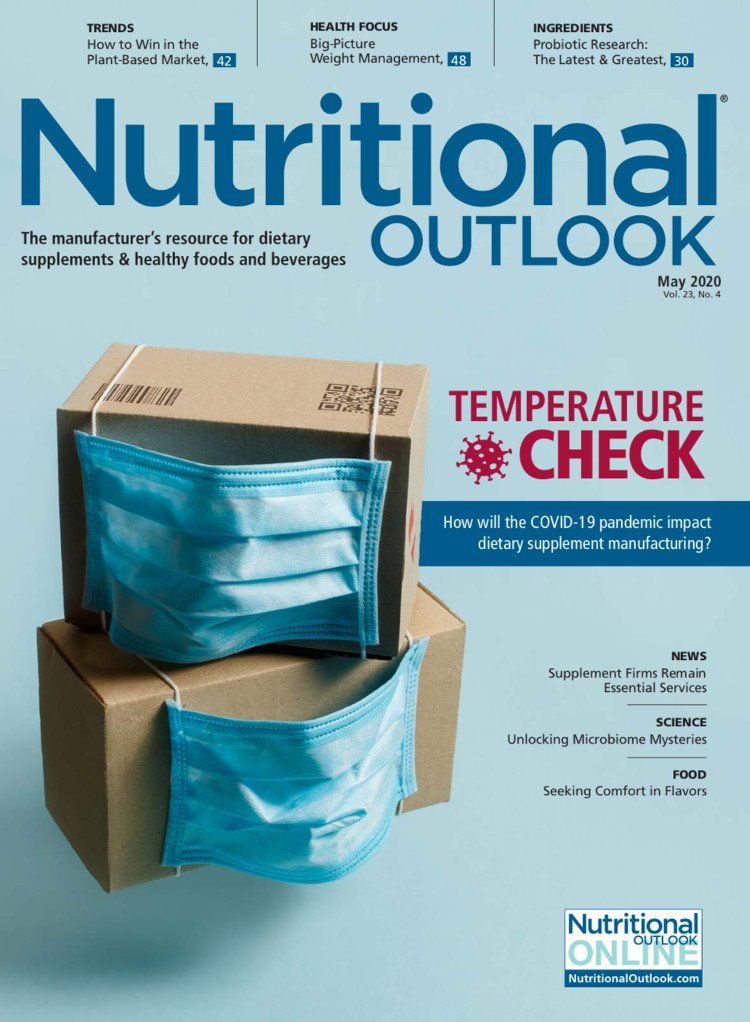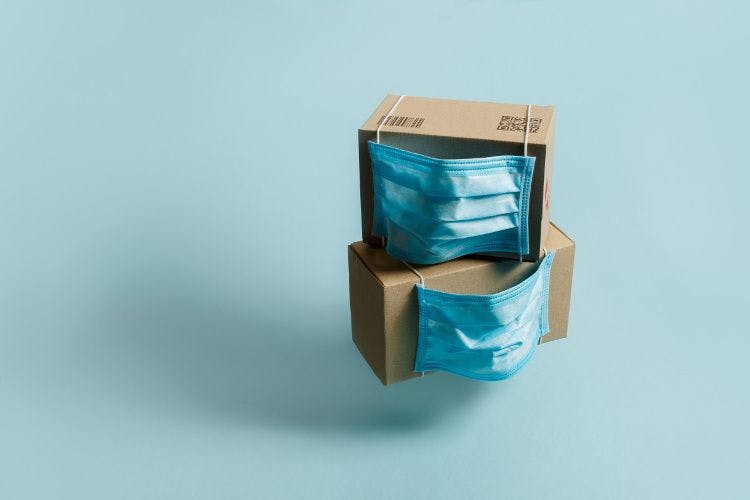COVID-19 and the Dietary Supplement Supply Chain
What was one of the first supply chain obstacles dietary supplement firms faced due to the COVID19 pandemic? Shipping. Read about what speakers at Nutritional Outlook’s April 16th webcast discussed.
Photo © AdobeStock.com/phaisarnwong2517

One of the first disruptions dietary supplement ingredient suppliers experienced at the outset of the COVID-19 pandemic involved logistics-specifically, transportation. Not only was labor not available to transport goods, but companies faced severely spiked transportation costs.
Nutritional Outlook hosted a webcast on April 16th featuring several ingredient suppliers from various countries, as well as other industry experts, to learn about the challenges companies are facing as a result of the pandemic.
Watch this webcast free on demand
Transportation Troubles
Dietary supplement businesses, including retailers, manufacturers, and raw material suppliers, remain operational in many parts of the world today. Consumers, it turns out, regard supplements as essential during a pandemic, as skyrocketing sales indicate. While demand for supplements is growing, the initial disruptions caused by lockdowns and social distancing requirements definitely upended the industry’s supply chain.
In the early days of the lockdown in India where his company is headquartered, it was difficult to secure transportation and labor, said webcast panelist Shaheen Majeed, president worldwide of ingredients supplier Sabinsa (East Windsor, NJ).
“While we are 100% operational, there have been operational challenges with regard to staff transportation and shipping logistics,” said Majeed. “In many cases, we’ve been moving materials using our own transport and providing our own staff or labor. Labor was just not available-for example, unloading and loading of goods at docks and warehousing.” Despite these challenges, Majeed said Sabinsa continues to be able to transport its goods to its customers.
Still, it turns out that it now costs the company more to do so. Numerous speakers, including Majeed, testified that currently, the cost of transport has drastically gone up. “Logistical transportation costs have absolutely increased,” he said.
Wilson Lau, vice president of Nuherbs (San Leandro, CA), has observed these changes in China where his company primarily sources ingredients. Lau said, “Right now, airfreight from China is horrendous-prices spiked two to three times-and the availability is low because a lot of those air shipments’ bandwidth has gone to personal protective equipment (PPE), which is as it should. Also, the number of flights have been greatly reduced because people aren’t traveling back and forth between China and the U.S., China to Europe, etc.”
Another webcast panelist, Michelle Li, vice president of operations for supplier Scientific Living (Irvine, CA), expressed similar experiences. “In the past few weeks, we’ve seen some congestions due to the reduction in cargo flights and shipping vessels. And this is causing a delay in our shipping efforts. There’s no surprise that we do see a surge in transportation costs, especially for air freight, and as we heard earlier. Some of these costs are three to five times the amount we normally saw before the coronavirus outbreak. Ocean shipments are less impacted from a pricing-increase standpoint, but we are seeing longer lead times due to indirect services. These longer lead times at ports around the world also take into account customer clearance processes that have been extended to somewhat decreased inspection activities.”
Li added: “We’re not only seeing these changes and effects from our Chinese partners, but also our partners in India, South America, and parts of Europe.”
And Majeed said: “Sea and cargo transport is still somewhat limited and definitely more expensive, and by more expensive, I mean we’ve seen rates as high as 400% over normal rates. And while this will probably stabilize as more movement picks up (be it air or sea), more permissions are granted, and more workers are able to come back, we don’t see prices coming back to pre-virus days. That’s something we’ll just have to be mindful and careful of as we move on.”
Supply: Short and Long Term
And what about actual supply shortages? At this time, is there enough supply of ingredients out there to meet demand? The answer is largely yes-for now. Webcast panelist Ettore Milano, PhD, medicinal plant purchasing manager for supplier Indena S.p.A. (Milan, Italy), said, “The main issue of the moment relates to the logistics and transportation, not the sourcing of ingredients.”
Many companies had stored inventory of ingredients in the short-term-and smart companies even began stocking up when news of the COVID-19 pandemic first hit months ago. Said Sabinsa’s Majeed, “We certainly kicked it up a notch when reports not only from China but also from our Chinese office that various lockdowns were happening over there. We realized there would be a fundamental shortage throughout the world, and so we took action in late October or November to process more material and to stock up our warehouses. So, we’ve been airlifting immediate goods that our customers needed, and putting sea shipments that have been going out regularly for the past few months. So, we’re on track as of whenever the lockdown had happened. We’ve been adequately supplied, with our houses being full.”
Supply is sufficient for now, but that could change soon, panelists pointed out. Even if companies had built up inventory, that inventory won’t last forever. Said Nuherbs’ Lau: “On the supply side, we’re currently fortunate that we and our partners have quite a bit of inventory in stock, but for some herbs that are hot, such as honeysuckle, it’s going to be an issue because harvest is a month or so away, so as we burn through our current inventory due to increased demand, it’s going to be hard, with harvests being so close.”
He continued: “What I’m really worried about is the fall/winter, if there is a secondary outbreak of COVID-19 in China, in certain places, that might be more localized than, say, shutting down or quarantining a whole region or the country. When it happens to that level, are there going to be people to go harvest these fall crops? Or even the summer crops? If it does come back in the fall/winter, are there going to be people out in the fields picking it, or will they miss the harvest due to this, and there will be a severe supply chain shortage?”
“I think that’s true around the world,” he added. “It’s not specific to China. There are harvests going on here in the U.S., and if it’s more mechanized, then maybe one person on a big combine can go pick all the wheat up, but for example if you need people in the fields to pick apples, if you don’t have enough people out there, you’re not going to pick it. So that’s what I really worry about in the short-term/medium-term is how this is going to impact harvests as they come up. Once it’s harvested, then it’s just a matter of timing. The supply is there, but it’s a matter of getting it out, so that’s a bottleneck of days or months, but the issue is if you can’t get the raw input. Then you have a real supply issue.”
Sabinsa’s Majeed expressed similar concerns. “As the growing season progresses here in India, getting people into the fields to plant, to nurture, to harvest material for the world’s output is going to depend on a lot of factors, and it really comes down to how organized their systems were before this pandemic. [I]n India specifically, migrant workers have been hit hard, especially up North, and that’s going to have a short-term and a long-term effect that this nation will feel for months if not years to come.”
Lau said, “Hopefully I am always looking at things from the side of the farmer and being slightly pessimistic, but overall I think if anyone comes to you with an overly optimistic viewpoint of the supply chain and saying that they have everything under control, I’d be very worried. I think this is the time to have a Plan A, B, C, D, E, F, and then keep going down the line as far as you can.”
What Will Demand Look Like Later?
The fact that demand is significantly increased for dietary supplements overall, and for products for immune health specifically, has made it even more challenging to meet demand with current supply chain obstacles. Webcast panelist Jim Emme, CEO of Now Health Group, spoke to the increased demand. He said, “We’ve not only seen an increase in immune products; we’ve seen an increase in personal care, essential oils, aromatherapy, homecare systems. It seems like as people are quarantined at home, there are spa days that are happening because they can’t go to a spa. They’re doing it themselves. So, we’ve seen interruptions due to high demand across every category that we sell-not just immune products.”
Scientific Living’s Li said: “From a supply chain point of view, this growth can be somewhat double-edged, as we see many parts of our global supply chain struggle to keep up with the increase in these demands…We started bringing in extra inventory prior to the Chinese New Year, with the anticipation that there would be potential shutdowns. But between the extra inventory that we’ve been building and the shipments that are in route on the ocean as we speak, we are only fulfilling a portion of the void that’s created by the COVID-19 crisis.”
It’s also uncertain whether this higher demand will ultimately taper off to more normal levels later. Said Li: “Based on the current retail data, we do see a spike in demand for dietary supplements. One of our major short-term challenges is to really balance an inventory to meet the increase in demand, but also avoid severely overstocking. So, at this point, it’s difficult for us to tell if the increase in demand from what we see today will translate into longer-term, higher sales volumes for a lot of these products.”
She continued: “One scenario is if COVID-19 persists and we may continue to see higher unemployment rates and slowdown in our economy. As a result, are we going to see less discretionary spending for a lot of these health and wellness products? But on the other hand,…if we take a glimpse into future trends based on what we have already seen in China where e-commerce sales spiked during the three months of quarantine, and we continue to see that demand grow, after this quarantine has ended there is an optimistic mentality that maybe in the States, this preventative health and wellness mentality will perhaps stay, and we need to prepare for this.”
Ongoing Change
The only guarantee in the face of the COVID-19 pandemic is that obstacles and solutions will continue to shift. Said NOW’s Emme, “Overall we realize that there are many things that are fragile in this entire supply chain right now. It could be a transportation problem-just because we’re not having one today doesn’t mean we won’t have one tomorrow. The problems are changing by the hour. The challenges are occurring day in and day out, around the clock.”
Even as a country like China begins its initial recovery for now, other parts of the global are increasingly impacted, meaning that the supplement supply chain should expect to continue seeing challenges worldwide. Said Lau: “China’s back open and up and operational. However, my assumption is that COVID-19 is going to come in waves to different parts of the world. So, I think it’s going to be an ongoing challenge for the near future.”
Scientific Living’s Li said the same. “We did see the supply shock initially start off in China, but it’s now becoming a larger, global supply issue.”

HHS announces restructuring plans to consolidate divisions and downsize workforce
Published: March 27th 2025 | Updated: March 27th 2025According to the announcement, the restructuring will save taxpayers $1.8 billion per year by reducing the workforce by 10,000 full-time employees and consolidating the department’s 28 divisions into 15 new divisions.






















